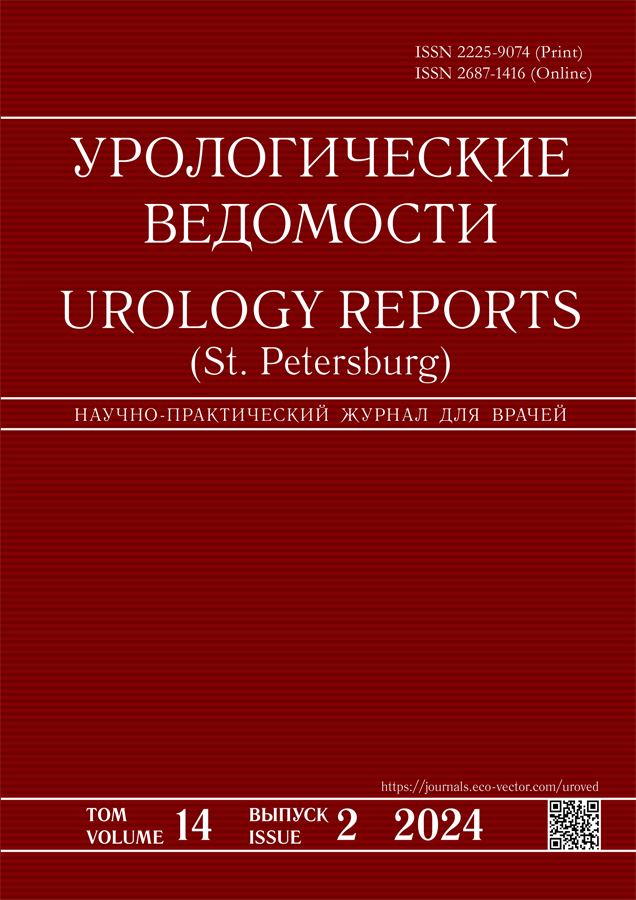Features of treatment of posterior urethral injuries in the acute period of traumatic disease
- Authors: Shanava G.S.1,2, Sivakov A.A.1, Movsisyan A.T.1, Shanava G.G.3
-
Affiliations:
- I.I. Dzhanelidze Research Institute of Emergency Medicine
- Almazov National Medical Research Centre
- Academician I.P. Pavlov First Saint Petersburg State Medical University
- Issue: Vol 14, No 2 (2024)
- Pages: 155-162
- Section: Original study
- Submitted: 19.01.2024
- Accepted: 13.06.2024
- Published: 08.08.2024
- URL: https://journals.eco-vector.com/uroved/article/view/625816
- DOI: https://doi.org/10.17816/uroved625816
- ID: 625816
Cite item
Abstract
BACKGROUND: Combined pelvic trauma in men in 10%–24% of cases is accompanied by damage to the posterior urethra, and no consensus on the treatment tactics has been established for such patients.
AIM: This study aimed to evaluate the results of treatment of patients with closed injury of the posterior urethra and traumatic shock.
MATERIALS AND METHODS: A retrospective analysis of the results of treatment of 46 patients with closed injury of the posterior urethra caused by a fracture of the pelvic bones and traumatic shock was performed. The average age of patients was 42.1 ± 9.9 years. The severity of urethral injuries was assessed according to the American Association for the Surgery of Trauma (AAST) classification.
RESULTS: The choice of treatment techniques depended on the degree of damage to the urethra and severity of traumatic shock. Upon hospital admission, 15 (32.6%) patients were diagnosed with grade I, 21 (45.6%) with grade II, and 10 (21.7%) with grade III traumatic shock. In grade I–II traumatic shock patients with incomplete urethral rupture, a urethral catheter was inserted, followed by conservative therapy. If a catheter insertion was possible, a retropubic revision of the urethra was performed. Patients with grade III–V urethral injury according to AAST and grade I–II traumatic shock underwent primary or delayed urethroplasty, such as urethral suturing and urethra-urethral anastomosis. Patients with grade III traumatic shock had a urethral catheter or cystostomy. In the long-term, 6 of 17 (36.9%) patients who underwent primary or delayed urethroplasty had short-term (up to 5 mm) urethral strictures, for which optical urethrotomy was performed. All patients with complete urethral avulsion who did not undergo early urethroplasty developed 10–20 mm strictures, requiring reconstructive surgery.
CONCLUSIONS: The choice of treatment techniques for patients with concomitant damage to the posterior urethra depends on the degree of damage to the urethra and severity of traumatic shock. The scope of treatment in the acute period may include urethral or suprapubic drainage of the bladder or reconstructive surgery.
Full Text
About the authors
Gocha Sh. Shanava
I.I. Dzhanelidze Research Institute of Emergency Medicine; Almazov National Medical Research Centre
Author for correspondence.
Email: dr.shanavag@mail.ru
SPIN-code: 1706-7410
MD, Cand. Sci. (Medicine)
Russian Federation, Saint Petersburg; Saint PetersburgAlexey A. Sivakov
I.I. Dzhanelidze Research Institute of Emergency Medicine
Email: alexei-sivakov@mail.ru
SPIN-code: 3064-8134
MD, Cand. Sci. (Medicine), Associate Professor
Russian Federation, Saint PetersburgArutyun T. Movsisyan
I.I. Dzhanelidze Research Institute of Emergency Medicine
Email: movs@mail.ru
SPIN-code: 2305-0087
MD
Russian Federation, Saint PetersburgGeorgii G. Shanava
Academician I.P. Pavlov First Saint Petersburg State Medical University
Email: baset.hunter@mail.ru
Russian Federation, Saint Petersburg
References
- Durrant JJ, Ramasamy A, Salmon MS, et al. Pelvic fracture-related urethral and bladder injury. J R Army Med Corps. 2013;159(S1): i32–39. doi: 10.1136/jramc-2013-000025
- Klemm J, Marks P, Dahlem R, et al. Contemporary management of pelvic fracture urethral injuries. Urologie. 2022;61(6):602–608. [In German] doi: 10.1007/s00120-022-01833-4
- Dane B, Baxter AB, Bernstein MP. Imaging genitourinary trauma. Radiol Clin North Am. 2017;55(2):321–335. doi: 10.1016/j.rcl.2016.10.007
- Horiguchi A. Management of male pelvic fracture urethral injuries: Review and current topics. Int J Urol. 2019;26(6):596–607. doi: 10.1111/iju.13947
- Zhang Z, Fang L, Chen D, et al. A modified endoscopic primary realignment of severe bulbar urethral injury. J Endourol. 2021;35(3):335–341. doi: 10.1089/end.2020.0567
- Battaloglu E, Figuero M, Moran C, et al. Urethral injury in major trauma. Injury. 2019;50(5):1053–1057. doi: 10.1016/j.injury.2019.02.016
- Beloborodov VA, Vorobev VA. Surgical reconstruction of the urethra posterior wall. Siberian Medical Review. 2017;(3):13–20. doi: 10.20333/2500136-2017-3-13-20 EDN: YUBVYJ
- Khadjibaev AM, Rashidov MM, Urinbaeva NM. Diagnosis and management of lower urinary tract injuries. The bulletin of emergency medicine. 2018;11(3):37–43. EDN: FPTRPT
- Belyi LE. Emergency urology. Manual for doctors. Moscow: OOO Medical Information Agency; 2011. 472 p. (In Russ.)
- Scarberry K, Bonomo J, Gómez RG. Delayed posterior urethroplasty following pelvic fracture urethral injury: Do we have to wait 3 months? Urology. 2018;116:193–197. doi: 10.1016/j.urology.2018.01.018
- Chaker K, Bibi M, Ouanes Y, et al. Comparison of long-term results according to the primary mode of management of injury for posterior urethral injuries. Int Urol Nephrol. 2023;55(8):1971–1975. doi: 10.1007/s11255-023-03648-4
- Leddy L, Voelzke B, Wessells H. Primary realignment of pelvic fracture urethral injuries. Urol Clin North Am. 2013;40(3):393–401. doi: 10.1016/j.ucl.2013.04.008
- Seleznev SA, Bagnenko SF, Shapot YuB, Kurygin AA. Traumatic disease and its complications. Saint Petersburg: Polytechnic; 2004. 214 p. (In Russ.)
- Makhnovsky AI, Ergashev ON, Barsukova IM, et al. Prognostic criteria for substantiating surgical and evacuation tactics in patients with polytrauma in level II and III trauma centers. Parfenov VE, editor. Saint Petersburg: St. Petersburg institute of emergency care n. a. I.I. Dzhanelidze; 2020. 42 p. (In Russ.) EDN: DGKTYR
Supplementary files












